Vajrasana: Health Benefits, Steps and Types
What is Vajrayana?
The Vajrasana name comes from the Sanskrit words vajra, a weapon whose name represents to “thunderbolt” or “diamond”, and asana (asana) means “posture” or “seat”.Vajrasana has been called after the shape it takes – a diamond or thunderbolt. This asana is pronounced as vahj-RAH-sah-na.
The name Vajrasana indicates a medieval meditation seat, but its usage varied. If there is one holistic position that you can slip into easily, and still, achieve a variety of benefits, it is the Vajrasana, the Adamantine Pose.
A sitting yoga asana is called Vajrasana in Sanskrit. This position provides a deep stretch for the quadriceps and tops of the feet, and it is said to help digestion. Vajrasana is a transitional or resting pose between asanas, and it is frequently employed as a meditation pose. The vajra Nadi, a network of routes via which prana moves in the body, is said to be activated by Vajrasana. In addition to helping digestion, the vajra nadi assists in the activation of kundalini energy. As a result, Vajrasana is one of the best poses for boosting Agni (digestive fire).
What are the different names of Vajrasana?
Vajrasana is also known as :
- Adamantine Pose
- Diamond Pose
- Pelvic Pose
- Thunderbolt Pose
- Kneeling Pose
What are the Health Benefits Of performing Vajrasana?
Improves our Digestive System
Vajrasana helps our digestive system by restricting blood flow to our legs and thighs while improving blood flow to our stomach. This aids us to get rid of constipation and enhances our bowel movements. Vajrasana also helps in the elimination of gas and acidity. It makes sure that our bodies absorb nutrients more effectively.
Relieves Low Back Pain
Vajrasana strengthens the lower back muscles, bringing relief from stiffness and pain. It also helps in the relief of sciatica pain.
Relieves Rheumatic Pain
Vajrasana provides to strengthen the flexibility of the muscles in our thighs and feet, as well as the muscles in our hips, ankles, and knees. This helps in the relief of rheumatic discomfort caused by stiffness in these locations.
Helps to calm our mind
Vajrasana is an awesome asana for meditation. Breathing exercises in this pose helps to quiet our minds and boost our emotional well-being. Vajrasana helps to reduce stress, improve concentration, and avoid depression and anxiety.
Prevents anxiety and stress
The repetitive breathing pattern helps your mind to relax and release any negative thoughts it may have been carrying. Not only that, but good digestion relieves you of any bodily discomfort you may be feeling, putting you in a relaxed and positive frame of mind where you can focus on the pleasant aspects of life while ignoring the stressful aspects.
Improves posture
One of the conditions of Vajrasana is that you keep your back straight at all times. This permits you to hold the position for longer periods while also allowing you to absorb more of the posture’s advantages. Daily practice of this pose will condition your back to be elongated all of the time, resulting in improved posture.
Helps in weight loss
As previously stated, the body’s digestion is increased by redirecting blood flow away from the legs and toward the pelvic region. Better digestion suggests that food is broken down more efficiently, which means that fat is not collected as quickly. If you’re trying to reduce weight, Vajrasana should become a regular practice in your life for greater outcomes.
Improves focus and concentration power
The practice of this asana needs deep and focused breathing, which permits you to devote your full attention to your breath. It will works the same way even if you are not closing your eyes and focused on an external item. It allows your brain to focus on one subject at a time without being diverted.
Reduces Obesity
Vajrasana improves digestion and helps in the reduction of abdominal fat. It has been reported to aid people lose weight and decrease their BMI (Body Mass Index).
Helps in reducing menstrual cramps
Periods are a normal event. Every 28 days, every young lady goes through the process. Period cramps, on the other hand, can be agonizing at times. This asana aids to relieve period pains by relaxing the waist and hip region.
What are Preparatory poses for Vajrasana?
- Sukhasana
- Shishuasana
- Pawanmuktasana
How to Perform Vajrasana Pose?
Sit with your legs extended straight in front of you.
Now, bend both the legs and sit in a kneeling position. Place the hips on the heels; the toes should point out behind you, and the big toes should touch each other at the back.
If you are a beginner, you may need to put a cushion under your feet for comfort to avoid ankle pain.
You can also choose to place a cushion or blanket above the feet and below the knees, in case of knee pain. Don’t forget to consult your doctor in case of some special medical problems.
Sit comfortably on the pit created by the parted heels.
Maintain your head, neck, and spine in a straight line. Put your palms on your thighs, facing upwards.
If you are an advanced yoga practitioner, stay in this pose for about 15 minutes, while taking long and deep breaths. Beginners may initiate within about 30 seconds, according to their comfort level.
Breathe out and relax.
Straighten your legs.
How to do Vajrasana by watching a video?
What are the follow-up poses for Vajrasana?
- Paschimottanasana
- Baddhakonasana
How to make the Vajrasana pose more comfortable?
If you see the Vajrasana pose uncomfortable, ask your yoga instructor to make sure that you’re performing it correctly. Some techniques you can use to alleviate discomfort include:
For ankle pain, think about putting a folded blanket or another uniform padding under your shins. Place the blanket so your toes hang off the back.
For knee pain, consider placing a folded or rolled blanket or towel across your calves and tucking it behind your knees.
For sitting discomfort, put a yoga block between your feet horizontally. Bearing some of your weight can take pressure off ankles and knees.
What are the types of Vajrasana?
There are three types of Vajrasana:
- Supta Vajrasana
- Supta Vajrasana Ashtanga/Laghuvajrasana
- Supta Urdhva Pada Vajrasana
Supta Vajrasana
What is Supta Vajrasana Meaning?
In Sanskrit, Supta refers to sleep or reclined, or supine. The word supine arrives from the Latin Word supinus means lying on the back. Both Supta and Supine might have arrived from the same common root. Vajra defines thunderbolt and Asana is a yoga position. Hence, it receives the name Supine Thunderbolt Pose or Sleeping Thunderbolt Pose, or Reclined Thunderbolt Pose.
Vajra also is the name of a Nadi that controls the motions of the sexual organs. Therefore this yoga pose empowers the performer to get mastery over sexual activities.
Although there are fourteen alternatives during this Supta Vajrasana, practicing one and mastering it’s enough to tone your body. Supta Vajrasana is a modern and reclined version of Vajrasana where the upper body reclines backward, so the rear rests on the floor. The arms rest on the floor to either aspect of the trunk, with the palms facing up.
Supta Vajrasana Benefits:
There are several benefits you can enjoy if you do Supta Vajrasana yoga regularly. Some of them involve the following:
Stretches The Body
Supta Vajrasana can essentially stretch multiple muscle groups in your body. It can stretch your back, chest, abdomen, and thigh muscles as well. This also improves the body’s flexibility and tones the muscles.
Helps in Improving Respiratory Disorders
Since the pose opens your chest region, it rises the oxygen flow into the respiratory system. This, in turn, boosts respiratory disorders such as asthma. In addition, it can also improve your cardiovascular health.
Improves Digestion
Doing Sleeping Thunderbolt Pose also aids in alleviating digestion-related issues such as constipation. This happens as the pose gives a gentle massage of the abdominal organs and improves blood circulation.
Corrects Body Posture
While stretching your back, you also boost your body’s alignment and thus, correct any bad posture that might happen due to a sedentary lifestyle.
Strengthens ankle, thigh, and hips
It is believed that if you practice Supta Vajrasana yoga regularly, it can make your hips, ankles, and thighs stronger. This happens due to the rise in blood flow and hence better oxygen supply to the muscles. With a strong lower body, your chances of injuries decrease.
Relaxes Mind
Since the pose also concentrates on deep breaths and relaxation, it can calm your mind and decrease anxiety and stress effectively. the daily practice also boosts blood circulation in the brain which aids in calming the mind and releasing stress.
Improves Sexual Health
This yoga can also boost your sexual health by strengthening reproductive organs in both females and males. The stretch of sexual organs and less stress also activate the hormones that increase sexual performance.
Apart from the ones mentioned above, Supta Vajrasana also aids in:
- Preventing cholesterol.
- Decreasing the risk of cardiovascular diseases.
- Boosting kidney and liver functions.
- Regulating functions of adrenal glands.
- Improving confidence and self-awareness.
What are the Preparatory Poses for Supta Vajrasana?
Before doing Reclined Thunderbolt Pose, One should get mastery over Thunderbolt Position first.
How to do Supta Vajrasana ?
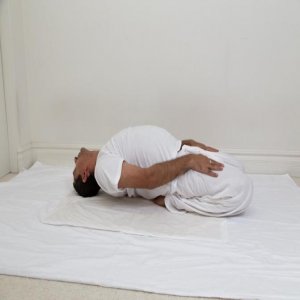
Sit comfortably in Vajrasana.
Keep your palms on the ground beside the buttocks, your fingers pointing to the front.
Slowly flex back, putting the proper forearm and also the elbow on the bottom so the right.
Slowly bring down your head to the floor while arching the back. Put your hands on the thighs.
Try to stay the lower legs connected with the floor. If necessary, spread the knees.
Make certain that you simply don’t seem to be over straining the ligaments and muscles of the legs.
Close the eyes and relax the body.
Breathe deeply and slowly within the end position.
Let go within the reverse order, breathe in, and take the support of the elbows, and also the arms lift the top higher than the bottom.
Then shift the weight on the right arm and elbow by slippery the body, then slowly returning to the starting position.
Never leave the last position by straightening the legs first, otherwise, you dislocate the knee joints.
Repeat this process 4 to 5 times and once you master it rise the time 8 to 10 times.
Variation of Supta Vajrasana:
This position has one variation called Eka Pada Supta Vajrasana or Single Leg Reclined Pose. In this variation, one leg is in place under the body and another leg is stretched out.
Precautions for Supta Vajrasana:
To avoid any complications and injury, make sure you consider the following things before doing Supta Vajrasana:
- Pregnant women should not perform this yoga pose.
- This pose is also not comfortable for people who suffer from sciatica or any other spine disease.
- You should also prevent this yoga or even other yoga poses such as Purna Supta Vajrasana and Supta Urdhva Pada Vajrasana after having a meal. Only Vajrasana can be performed after a meal.
- Do not extend the legs first to release the pose as it can dislocate the knee joints.
- Those who have high blood pressure should also not perform Supta Vajrasana.
- If you are undergoing menstruation, you should not perform this yoga pose.
Supta Vajrasana Ashtanga/Laghuvajrasana
What is Laghuvajrasana?
Laghu vajrasana is an advanced backbend that can encourage increased flexibility of the spine while opening up the heart and chest to permit deep breathing. The name arrives from the Sanskrit laghu, which defines “small,” vajra, which means “thunderbolt,” and asana refers to “pose” or “posture.”
Little Thunderbolt (Laghu Vajrasana) is involved in Ashtanga yoga’s second series. The Ashtanga version is performed with your hands on your ankles. The modification shown here deepens the intensity of the backbend by drawing the crown of your head to your feet and the hands to your thighs. The Ashtanga version is pretty approachable if you are comfortable in Camel Pose (Ustrasana). Lowering backward and raising with control works the thighs. You can use this posture in sequences that are concentration on the back, heart openers, and core. To warm up for this position, it is best to perform Sun Salutations and poses that open the hips and chest.
Benefits of Laghuvajrasana:
- This pose improves spinal mobility.
- Opens the throat, chest, psoas, and quadriceps.
- Strengthens the spinal and abdominals support muscles.
- Practicing this pose will aid strengthen your legs as needed for deeper back bends.
- It opens the third eye chakra, heart chakra, and throat chakra.
How to do Laghuvajrasana:
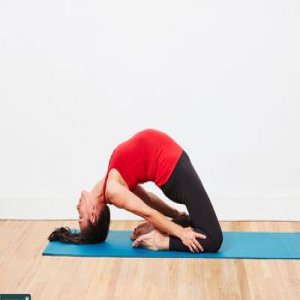
Start in a kneeling position with your thighs perpendicular to the ground.
Raise your chest to lengthen your spine as you move back to Camel Pose.
Bring your hands to grab your ankles.
Tilt your head back.
With control that comes from grounding through the legs, tilt your head back and slowly lower the crown to the floor, coming into a backbend.
Keep your arms extended and hold on to your ankles the entire time.
To come out, engage the core and move back up to kneeling.
Modifications and Variations for Laghuvajrasana:
- This pose will take practice. Once you can perform it with good form, there are ways to deepen it.
- If you find it hard while lowering yourself all of the ways or coming back up, lower yourself only midway and hold before coming up.
- Another modification is to put a block under your head.
If you have a bendier back, try this variation:
- Instead of grabbing your ankles, keep your hands on your thighs as you rest back.
- When your head comes to the floor, move your hands down your thighs toward your knee.
- This is a tighter version of the position. maintaining your hands on your thighs means that your head may come to rest between your feet.
Common Mistakes while doing Laghuvajrasana:
Avoid these errors to perform this pose correctly.
Attempting Before Ready
This is an intense pose and should only be practiced by students with a strong back-bending practice. You should be coached by a yoga instructor when first doing this pose.
Crunching Lower Back
ensure to keep the chest moving up and the glutes soft to elongate the spine and prevent crunching the lower back.
Safety and Precautions for Laghuvajrasana:
- Do not perform this modern pose if you have not perfected your Camel Pose.
- Prevent it if you have injuries to your back, neck, or knees.
Supta Urdhva Pada Vajrasana
What is Supta Urdhva Pada Vajrasana?
Supta Urdhva Pada Vajrasana a.k.a “Sleeping-Upward-Leg-Thunderbolt-Pose” is a modern spinal twist position that aids maintain the flexibility earned during your yoga asana practice.
Benefits of Supta Urdhva Pada Vajrasana:
- Increases flexibility of the hips and spine.
- Stretches the quadriceps muscle.
- Strengthens the lungs.
How to do Supta Urdhva Pada Vajrasana?
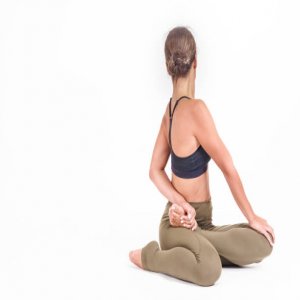
Start from Dandasana or ‘Staff Pose’ i.e. sitting on the ground with both of your legs extended in front of you.
Bend your left leg back and square your hips.
Then inhale and bend your right leg into a half-lotus position whilst turning your torso towards the right.
Then exhale and reach your right arm around your back and grab your right big toe with your first two fingers and thumb and
Place your free hand on high.
Hold the pose for five full breaths.
On the inhalation, straighten your spine.
On the breathe out, try to turn further back.
Make sure you tuck your chin in ever so slightly when looking back over your shoulder.
Contraindications and Cautions for Supta Urdhva Pada Vajrasana:
- Prevent this posture if you have any issues with your knees or if you have tight adductors.
What are the Precautions To Take While Performing Vajrasana?
To get the most out of Vajrasana, it’s essential to remember these precautions:
- The person doing Vajrasana should not be in a hurry.
- Those who have issues with the spinal cord, particularly the lower vertebrae, should not be very worried.
- Please do Vajrasana training under expert guidance and counsel if you have intestinal ulcers, hernia, or other ailments of the small and large intestines.
- Allow the back muscles’ strength to gradually increase before gradually increasing the length of this posture.
- This pose should not be practiced by anyone who has a bone condition.
- If you start to feel dizzy, feel back pain, develop acne, or feel increased pain in your knees or other body parts, immediately stop.
- Do this posture and consult a doctor.
- People who are overweight should be monitored by a Vajrasana Yoga professional so that they can gain prompt aid if there is a problem.
- This Vajrasana posture should be avoided by pregnant women.
What are the Contraindications Of Vajrasana/Diamond Pose Asana?
If you have tight joints or find it hard to move, Vajrasana should be approached with caution. Slowly transfer your weight to your heels. To do so, distribute your weight evenly between your hands and shins, avoiding extra strain on your knees. At least at first, take it carefully while practicing this stance.
- Injured Ankles or Knee Ligaments: This posture can be hard on the knees and ankles if these muscles and joints are not flexible. If you have damaged ligaments in your knees or ankles, this position is not for you.
- Hernia or Ulcers: Those with hernias or ulcers in their intestines should look for medical counsel and assistance before doing this position, and should perform so under the supervision of a certified yoga instructor. This pose’s pressure on the anus may put excessive strain on the intestine.
- Runners with Hamstring or Calf Injuries: If you have hamstring or calf problems, you should avoid this.
- Knee Arthritis: This exercise is not suggested for persons who have severe knee arthritis.
The takeaway
A relatively simple kneeling pose, Vajrasana has several advantages, including helping with digestion, hypertension, and constipation. Before you begin a yoga program, check with your doctor. If you have certain conditions such as spinal cord or knee concerns or issues related to your large or small intestine, consider removing Vajrasana from your practice.

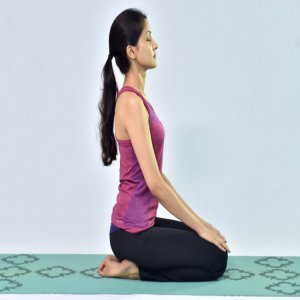
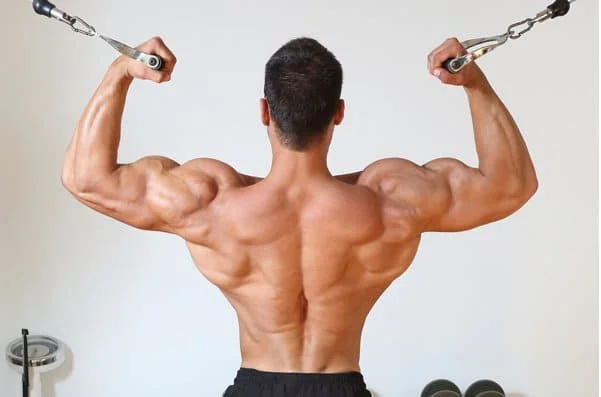
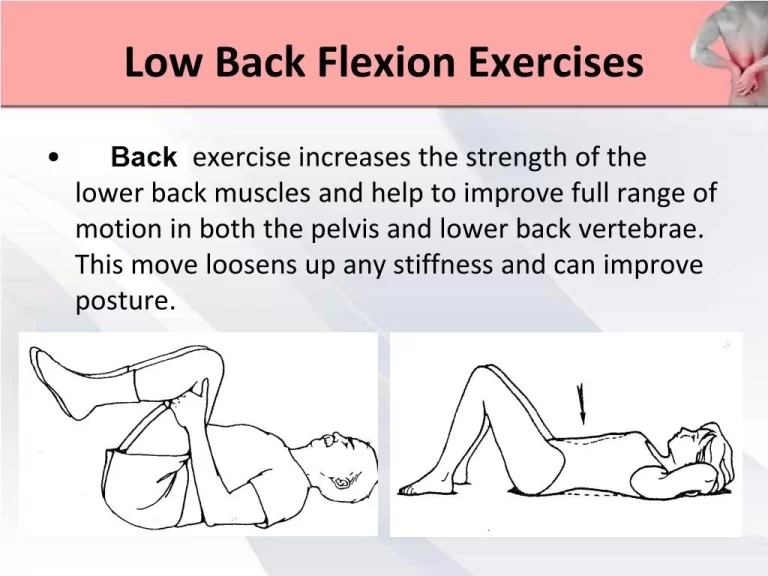
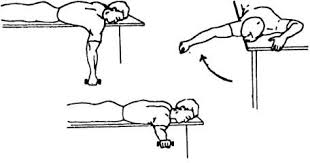

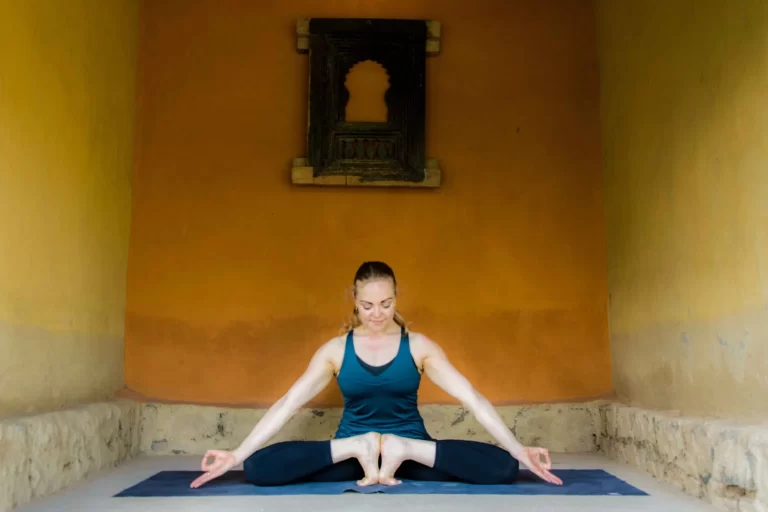
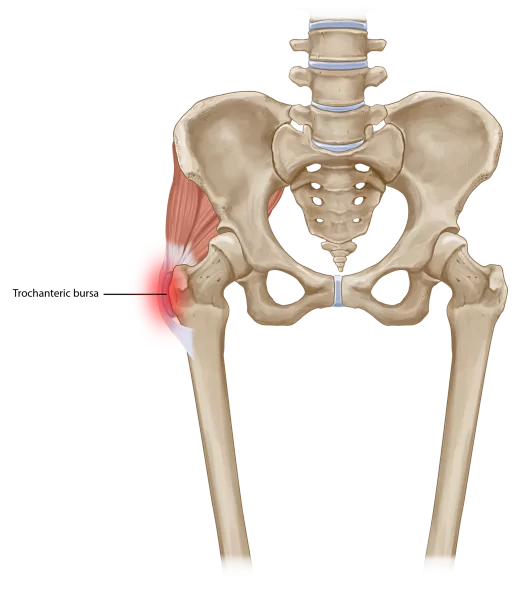
3 Comments